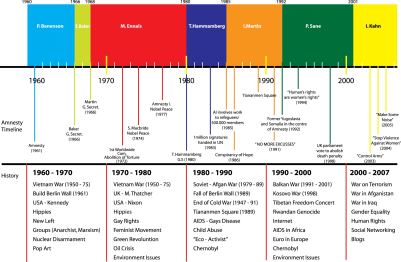Filed under: History | Tags: amnesty, brand development, branding, future, History
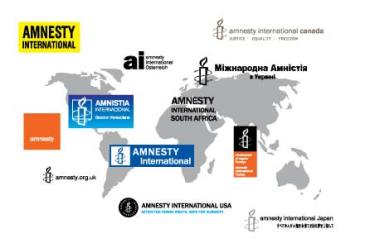
For a quick view about Amnesty it is easy to realize that Amnesty’s identity is different between the countries. I am from Greece and the identity of Amnesty is so different from that in U.K. Different colour, the logo, the font and of course the design. It is sure that this impacts and in the image of Amnesty Worldwide. Somebody can say that human rights are international and they have to be adopted in each country under the traditions and the habits of its people. But we live in the era of the globalization. Ideas, news and trends deliver very quick through the media, like the Internet. The habits and the way we act are not so different between the countries. So I think that it is important for the future of Amnesty to redefine its position and its identity.
Amnesty was designed in 1961 and we passed 50 years. So its identity needs to redesign. At the same time it has to be the same worldwide. This will give a more clear image in the operation of the brand and also will strength its prestige.
Amnesty International is one…It is the same everywhere…Its aim is to protect human rights… It is the organization which fights anybody who try to abuse the human rights… This view must be performed during the identity of Amnesty International.
Logo – colour – sites – campaigns – strategy have to be the same…
Filed under: History | Tags: amnesty, brand development, branding, charities, human rights
Today Amnesty has 2.2 million members in more than 150 countries. The center of Amnesty International is in U.K. and especially in London. After that Amnesty has different local groups in the same country and of course worldwide. Each group has its missions but all of them operate under the same strategy of Amnesty International.
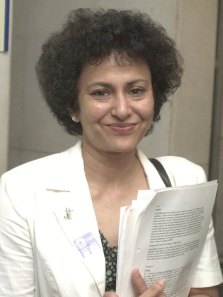
The Secretary General is in Amnesty International in London. Secr. General and the Commission take the decisions about the strategy plans and the management of Amnesty. This time Irene Khan is the Secretary General of Amnesty International. She is the first woman, the first from Asia andthe first Muslim, who holds this hard position i the structure of Amnesty Int.
The most important events of Amnesty Inter. these days are:
- Olympic Games in Beijing
- Tibet
- Stop Women Violence
- Control Arms
- Abolish death penalty
Amnesty International is trying all the time to be the last hope of the people worldwide. The prisoners of conscience holds the first place in the causes of Amnesty but there are also more than 4000cases. Amnesty operates like a world newspaper. It receives information for illegal prisons and trials and when Amnesty evaluates that this information is real, it starts a race with campaigns and actions with the help of its members to press the governments to take decisions for the protection of human rights.
Independence – Impartial – Neutral are the 3 basis of Amnesty International organization. They are the keys about its development.
Filed under: History | Tags: Arts, branding, brands, charity, design, volunteering, young people
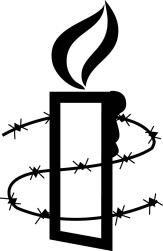
Amnesty International (AI) is an independent, non-profit organization, which protects and campaigns for the Human Rights. It is a worldwide movement of ordinary people who help ordinary people.
AI was founded in 1961 by Peter Benenson, an English lawyer who established an article, called “The Forgotten Prisoners”, in The Observer Newspaper. The reason that this article was written by him, was the imprisonment of two Portuguese students, because they raised their glasses of wine in a toast to freedom.

Peter (Solomon) Benenson was born in 1921. His father, Harold Solomon, was a brigadier-general in the First World War and his mother Flora Solomon (Benenson) was the daughter of Grigory Benenson, Russian-Jewish banker in Russia. Benenson lost his father when he was 9 years old, by an accident. After that he had a privately tutor, W.H Auden. Then he studied history in Eton College and in the Oxford University, but the Second World War was the reason to interrupt his studies and to join the military. His Russian background was a basic factor that navy rejected him. During his military service, Benenson studied law and he focused on human rights. In 1946 he joined the Labour Party and he was the leader in the society of Labour Lawyers. Through Labour Party, Benenson had different activities relevant to human rights, which in 1948 was established the Universal Declaration of Human Rights. He was observer in different trials, as in 1956 the “Treason Trial” of Nelson Mandela.
His activities merged when he was 15 years old, when he organized support for the Spanish Relief Committee. In the same time he adopted one baby of himself and he tried to help Jews from Nazi. He raised 4.000 pounds to bring two German Jews in Britain.
In 1960 Benenson read the article about the two Portuguese students and this was the time that Amnesty was born. But Benenson wasnt alone. It was a committee included Benenson, Eric Baker, Louis Blom-Cooper, Peggy Crane and Peter Archer. The two of them were playing a basic role in this project.
Luis Blom-Cooper is a English author and lawyer. He is the person who had a basic role in “The Observer” newspaper and who suggested Benenson to write this article.
Eric Baker was the second important person of the idea “Appeal Amnesty 1961”. Benenson met Eric Baker in Cyprus between 1950 – 60. Baker was a human rights activist and during this period he made four peace missions in Cyprus. His meetings with Benenson were crucial and important for their future. Baker was the person who create the term “Prisoner of conscience” and which was the main idea which used by the Amnesty.
So in 1961 Amnesty International was founded and in the same year delegates from France, Ireland, UK, USA, Belgium and Switzerland met in Luxembourg to establish the international movement.
Also Benenson asked from Diana Redhouse, an English artist, to design the Amnesty’s logo. The inspiration was by the Chinese proverb…”better to light a candle than to curse the darkness”….The result is the candle in barbed wired…
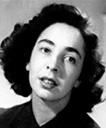
In this stage it is important to research the historical context of Amnesty and what were the historical, political and social events this period.
1960 – 1969
- Vietnam War
- Build Berlin Wall
- USA – Kennedy
- Hippies
- New Left – Socialism
- Nuclear Disarmament
- Pop Art
Amnesty Timeline (1960 – 69):
- 1964 – Benenson called “President”
- 1966 – Benenson left Amnesty and Baker was the 1st General Secretary
- 1968 – Martin Ennals was the 2nd General Secretary (1968 – 1980)
Martin Ennals was an human rights activist. He was the person who changed the perception of Amnesty. Before he was General Secretary, AI had 7 staff and 17.000 pounds annual income. Next year there were 150 staff and 2 millions pounds annual income. When Ennals was General Secretary in AI, Amnesty won the Nobel Prize Award in 1977 and the UN Human Rights Award 1978. He tried to make an strong campaign organization.
1970 – 1979
- Vietnam War
- UK – M. Thatcher
- USA – Nixon
- Hippies
- Gay Rights
- Feminist Movement
- Green Revoluntion
- Oil Crisis
- Environment Issues
Amnesty Timeline (1970 -79) :
- 1st Worldwide campaign – Abolish Torture (1972)
- Sean Macbride won the Nobel Prize (1974)
- AI won the Nobel Prize Award (1977)
- AI won the UN Human Rights Award 1978
1980 – 1989
- Soviet – Afgan War
- Fall of Berlin Wall
- End of Cold War
- Tiananmen Square
- AIDS – Gays Disease
- Child Abuse
- Chernobyl
- “Eco – Activist”
Amnesty Timeline (1980 – 89)
- Thomas Hammamberg General Secretary (1980 – 85)
- 1 million signatures handed in UN
- AI involves work to refugees. 500.000 members (1985)
- “Conspiracy of hope” (1986)
- Tiananmen Square (1989)
T. Hammamberg is a Swedish Diplomat and human rights activist. He was a General Secretary in Amnesty in 1980 to 1985. Before this he was a teacher and journalist in Sweden (1969 – 79). He was Chairman of the International Execute Committee in AI (1976 – 79)
1990 – 1999
- Balkan War
- Kosovo War
- Tibetan Freedom
- Rwandan Genocide
- Internet
- AIDS in Africa
- Euro in Europe
Amnesty Timeline (1990 – 99)
- Ian Martin – General Secretary (1986 – 92)
- Pierre Sane – General Secretary (1992 – 2001)
- Former Yugoslavia and Somalia were in the center of AI campaigns
- “NO MORE EXCUSES”
- “Human’s rights are women’s rights
- UK parliament voted to abolish death penalty
Ian Martin is an English human rights activist. Representative UN in Nepal
Pierre Sane was the Secretary General in AI. He born in Dakar and he studied Political Science at Carleton University and MBA in Bordeaux in France. During his time in AI he reorganized the whole view and strategy of the organization. His most important activities were:
- World Conference of Universal Declaration of Human Rights
- World Conference on Women in Beijing
- 50th Anniversary of UDHR
Also he led some famous and successful for the Amnesty campaigns:
- Women’s rights
- Human Rights Defender’s
- Socio-economic and cultural rights
- abolition of torture and death penalty
2000 – 2007
- War on Terrorism (11 Sep. 2001)
- War in Afghanistan
- War in Iraq
- Gender equality
- Social Networking
- Blogs
Amnesty Timeline (2000 – 07)
- Control Arms
- Irene Khan – Secretary General (2001 – present)
- Stop Violence Against Women
- Make Some Noise
Irene Khan is the 1ts women Secretary in AI. She is Bangladeshi and she studied law at the Victoria University of Manchester and in USA in Harvard Law School. She helped to create Concern Universal and she became human rights activist in 1979 with International Commission of Jurist.
AMNESTY STRUCTURE
- Peter Benenson ( 1961 – 1966) – President
- Eric Baker (1966 – 1968 – Secretary General
- Martin Ennals (1968 – 1980) – Secretary General
- Thomas Hammamberg (1980 – 1985) – Secretary General
- Ian Martin (1986 -1991) – Secretary General
- Pierre Sane (1992 – 2001) – Secretary General
- Irene Khan (2001 – Present) – Secretary General
